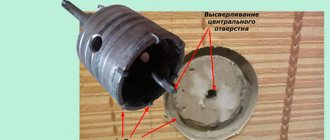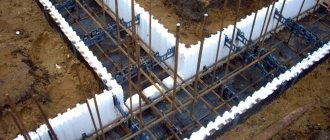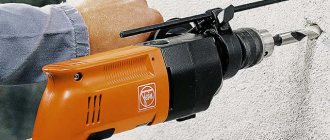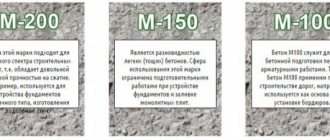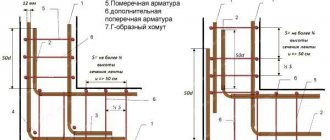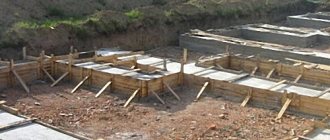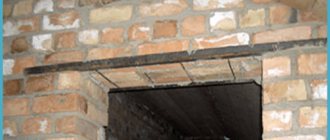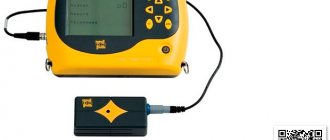Firstly, if you work with a high-quality hammer drill with a high-quality, expensive concrete drill in the drilling + slotting mode, you will pass through metal reinforcement and not even notice.
But I agree that the Pobedit drill is not intended for drilling reinforcement. Therefore, if you come across reinforcement, you need to change the drill to a regular metal drill, and first of a smaller diameter (for example, if you are drilling an 8 mm hole, take a 6 mm metal drill). The metal drill must be well sharpened, then you can drill a hole in the reinforcement without any problems, and do not forget to switch the hammer drill to the “drilling only” position.
Having drilled through the reinforcement without any problems, bring the hole diameter to the desired size by placing a metal drill of the required size.
This happens often.
What can be done in such a situation. If the weight of the object that is intended for hanging is small and the hole that was drilled (to the reinforcement) is several centimeters (at least 3 cm), then I try to do the following: I make a wooden chopper (cork, preferably made of birch). It should be its own part, entering the wall just along the hole, and the other - wider. That is, it should turn out to be such a wedge. And kill him. Then hammer in a nail or screw in a self-tapping screw. And try to hang an object on it. If this cannot be done, then welding is an option.
If you wish, you can get a welding machine, or find a welder.
What to do if you run into reinforcement while drilling concrete?
We had the same problem with the reinforcement in the concrete wall when we moved the sockets. The builders removed the interfering fittings in the hole using gas welding. Everything was very fast. I don’t know if this method will suit you, if you have the opportunity to find welding.
Try removing the reinforcement by welding.
What if you hit reinforcement while drilling concrete?
cut with a grinder, or drill out the reinforcement.
During repair and construction work, it becomes necessary to make a hole in a concrete wall, which will not cause problems if you have a professional set of tools. But you don’t always have a hammer drill and a pobedite drill at hand. This means you have to go to the store and spend a lot of money. But if you need to make one small hole, then it is enough to use ingenuity and take advantage of the existing experience of home craftsmen.
When you have everything you need
In order to drill through a concrete wall, you need a drill and a bit; without them, this work cannot be done. If you have a puncher, the procedure will take no more than a couple of minutes:
- secure the drill;
- if this is important, install a limiter nozzle;
- mark the hole with a construction pencil;
- if you have a punch, it is advisable to make a notch;
- start drilling.
During operation, it is recommended to gradually increase the speed so as not to subject the tool to excessive load. Moreover, with rapid rotation at the start, the cutting edge will begin to shift, which can lead to distortions.
Approximately the same procedure is performed if you have an impact drill. Although there is some limitation here. Its power is not always enough to make a hole with a diameter of more than 8 mm, even if the manufacturer claims otherwise. In this case, it is recommended to split the work into two parts. First use a drill of a smaller diameter - 4-6 mm. Then expand the resulting hole to the required size.
If there is no limiting cap, you can use regular electrical tape. It is enough to attach the dowel to the drill and wrap a couple of layers along its length. This will allow you to avoid doing unnecessary work and not going deeper than the required distance.
If you don't have an impact drill
In the case where you only have a drill at hand without a hammer function, you will need a special punch. Its task is to crumble or make a crack in the solid fraction. Of course, this will slow down the work somewhat, but ultimately the goal will be achieved. The sequence of actions here resembles regular drilling, with minor changes:
- mark the hole;
- place a punch and hit it several times with a hammer;
- drill until you can get deep inside;
- put the drill aside and use a punch again to break up the coarse fraction;
- checked again, before the next obstacle.
One hole of small diameter can take up to 10 minutes, and during this time the nozzle will experience increased temperature loads. Ordinary water can deal with them, just dip the drill into it for a few seconds. However, you should be careful and prevent liquid from getting into places where electric current passes.
Before you start drilling into a concrete wall, you need to make sure that there is no electrical wiring in the future hole. Usually it is not visible under a layer of plaster, so it is recommended to use a tester. If it is not available, a regular indicator screwdriver for 50 rubles, which is sold in every hardware store, will help. It is necessary to take it with your bare hand by the sting and lean the back side against the place of work. The presence of wiring will be indicated by a lit light.
Methods for drilling concrete
The choice of method for making holes in concrete depends on the tasks:
- If it is necessary to obtain a hole of small diameter, for example, to install a dowel in concrete, then use a hammer drill with a special drill with a carbide tip.
- If it is necessary to obtain a large diameter, for example, for laying pipes, installing sockets, etc., use diamond drilling of holes in concrete using special crowns.
Now let's take a closer look at both technologies.
Carbide tip drill
Making holes with drills
Drills, or as they are also called, drills for concrete, have an auger-shaped rod and, as mentioned above, a carbide tip. The shank can be smooth and cylindrical, designed for impact drills, or made according to the SDS standard, for rotary hammers.
With their help you can make holes of small and medium diameter.
Instructions for performing this procedure are as follows:
- Before punching a hole in concrete, you need to mark the location that needs to be drilled.
- The tip is then inserted into the chuck of a hammer drill or drill. This sets the depth stop to the desired position.
In the photo - drilling with a hammer drill
- Next, the drill should be rested on the intended point and the tool should be turned on. In this case, you need to place a certain emphasis on the nozzle. Periodically, the drill must be removed from the hole and moistened with water, preventing it from overheating.
- Once the required depth has been reached, work is stopped.
It must be said that you can make a hole with a regular drill without impact. However, for this you will need a punch with a hammer. In such a situation, the drill must be periodically removed from the hole and the concrete must be broken with a punch.
Drilling with diamond bits
It often becomes necessary to make a large-diameter hole in concrete, for example, to install a sewer or water pipe. Today there are many companies that provide similar services. However, before you invite specialists, you should find out the cost of punching holes in concrete.
It is quite possible that you will decide to perform this operation yourself. To do this you will need the same hammer drill. The only thing is that you will have to purchase a diamond crown attachment.
Using such a tool you can make holes with a diameter of 100 mm or even larger. Moreover, a correctly selected bit will allow you to successfully drill even reinforced concrete structures and concrete of any hardness, with any filler.
Note! Toothed crowns can jam when meeting reinforcement, and their teeth, as a rule, break.
Thanks to this, you can get a hole in any concrete structure. For example, when constructing various wells, people are often interested in how to punch a hole in a concrete ring? A diamond tool can also easily cope with this task.
Drilling with a diamond bit
In addition, there are some other advantages of this method:
- The ability to obtain a hole of the required size in an absolutely round shape.
- There are no shock impacts or strong vibrations, which makes it possible to use this technology in houses that are under repair or reconstruction.
- There is no strong noise.
- Possibility of use when installing air conditioning systems, where sometimes pinpoint precision is required.
- Ability to drill at an angle, close to walls, floors or ceilings.
Advice! The price of crowns is usually quite high. However, if you follow the operating rules, the used nozzle can be restored. There are specialized companies that provide such services.
The drilling principle is the same as when drilling with auger drills. Including, it is necessary to periodically moisten the crown with water.
Drilling with professional tools
If you need to get a hole with a diameter of, for example, 20-50 cm or even more, then a hammer drill, of course, is not suitable for these purposes. In this case, you can drill a hole in the concrete using a professional tool.
Powerful equipment is not held in the hands like a hammer drill. Usually it is fixed to the wall using anchors. Sometimes fixation occurs using the spacer method using a rod, i.e. the lower part rests on the floor, and the upper part rests on the ceiling.
What is needed to drill through the reinforcement?
In order to make a hole in a steel bar, you will need a drill or hammer drill that operates in the “drill” mode. In addition to this tool, you will need a metal drill. It is recommended to use drills of grade P18 or P6M5. These products are coated with a titanium-containing alloy, and therefore have high strength. Typically, the color of such drills is black or dark gray, so they are quite easy to distinguish from the mass of other similar products. The tip of the drill needs to be sharpened: this will make it much easier to make a hole in the reinforcement. Professionals do not recommend using HSS brand drills, since they are much weaker in strength.
How to choose a drill for drilling reinforcement in concrete
The initial characteristic is the diameter of the hole, as well as the shape of the landing part. In this case, the drill is always designed for one-sided drilling, since for concrete surfaces it is almost impossible to align the axes of two holes that are drilled from opposite sides of the slab, wall or block.
How to drill reinforcement in concrete? In one pass, it is usually possible to obtain holes in the reinforcement if the maximum diameter of the cavity does not exceed 10 - 12 mm; in all other cases, preliminary drilling is performed first, and then reaming.
The choice of the size of the impact drill decides a lot. The disadvantage of a rotary hammer is that it sharply increases the level of vibration, and this will negatively affect the accuracy of the resulting hole. Considering that reinforced concrete has no plasticity, this circumstance will “help” break a hole or break off a piece of concrete along with under-drilled reinforcement.
Do I need to use a core or a bit? Experts think so. In addition, an impact drill with a rebar drill must be installed on a massive stand (or a tripod - when making vertical holes in the ceiling).
The best quality is obtained from hollow drill cores for reinforced concrete. They penetrate into the foundation only along the perimeter of the bit, leaving a cylindrical volume of concrete inside the tool. This piece is removed after drilling or periodically broken into pieces to ensure smooth operation of the drill. Drilling reinforcement in this way can be dry or wet (the second is preferable).
How to drill reinforcement?
Often, when cutting out a part of a reinforced concrete slab (or drilling a hole in it), the working tool gets into the reinforcement. In this case, you should stop work and replace the concrete drill (or core bit) with a metal drill of the recommended grades P18 or P6M5. These high-quality products can handle steel bars of any diameter.
It is better to start drilling the reinforcement with a thinner drill, for example, No. 3. The hole is then widened using a thicker drill bit. To protect it from overheating and increase the efficiency of the process, industrial oil I-20 is used. It is better if it is “winter”, that is, intended for use in the cold season. An oiled drill goes through steel better. Therefore, before starting work, you should prepare a small container in advance and pour a little oil into it. If this is not available, you can use ordinary water. But in this case, it is necessary to wet not only the drill, but also the existing hole in the concrete, as well as the reinforcement.
If you need to drill through a regular rebar that is not embedded in concrete, you will need a vice. They clamp a metal rod in them, moisten it in the right place with water and begin to drill a hole. The principle of operation here is the same: first, thinner drills are used, then thicker ones. During the process of forming a hole, the drill will inevitably heat up, so it must be periodically cooled by immersing it in a container of cold water. You also need to wash the recess in the rod with it, thereby cleaning it from metal chips and dust.
Diager drills: through reinforcement - easy!
products for professionals from professionals
Diager drills and bits are products for professionals in the field of drilling, manufactured at the Diager concern plant in France. Steel from Germany is used in the production of drills; carbide tips are manufactured at the Ceratizit plant in Luxembourg (supplier of all European premium drill manufacturers).
The main advantages of Diager drills are strength, long service life, speed and drilling accuracy. PGM certified
, which means they are ideal for drilling holes for mechanical anchors of the same standard.
Below we will talk about Diager drills designed for drilling reinforced concrete.
- New for 2020 is the sds-max Ultimax 646 drill with a monolithic carbide tip. Specially designed for powerful rotary hammers. The manufacturer claims that the drills penetrate reinforcement up to ø22 mm
, with an average
life of 150 m
in C50 concrete.
We decided to put these drills to the test and conducted our own little test:
Materials and equipment:
Drill Ultimax646 25*540mm Hammer drill Bosch GBH 8-45 Reinforced concrete block 400mm thick, reinforcement diameter 20mm in one layer
Results:
Drilling was carried out in the center of the reinforcement. The drill passed through the reinforcement in 8 minutes (4+4, break for 1 minute for cooling).
Feel:
The drill is perfectly balanced, vibration is low, and you feel comfortable while drilling. When passing through the reinforcement, the drill works like a drill for metal, removing short chips.
Conclusion:
The drill has proven itself to be excellent when drilling reinforced concrete, but for serial drilling of reinforcement we recommend using diamond core bits.
The Booster Plus drill for light hammer drills (SDS-plus shank) has no analogues - a monolithic three-beam pobedit tip with complex sharpening angles and a chisel effect resists reinforcement. The manufacturer declares an amazing resource: up to 1500 holes
in concrete grade B50!
The square spiral spiral has three channels combining passage, compression and depression chamber for accelerated removal of slurry. The drill is indispensable when the finishing work has already been completed - it drills perfectly round holes
and ensures
reliable fixation of the fasteners
.
The B3max reinforced concrete drill is designed for heavy hammer drills (SDS-max shank) and is similar in tip and spiral design to the Booster Plus drills.
The Ultimax reinforced concrete drill for SDS-max rotary hammers is the predecessor of the Ultimax 646. The Ultimax has increased strength and bending resistance. High temperature finishing ensures the strength of the tungsten tip. The unique anti-blocking system reduces the risk of the drill jamming in particularly hard and reinforced materials. Ultimax drills are suitable for drilling materials such as reinforced concrete, granite, stone, brick. The service life of the Ultimax drill is also stated to be impressive: up to 1000 holes
in concrete grade B50!
Reminder for working with Diager drills
